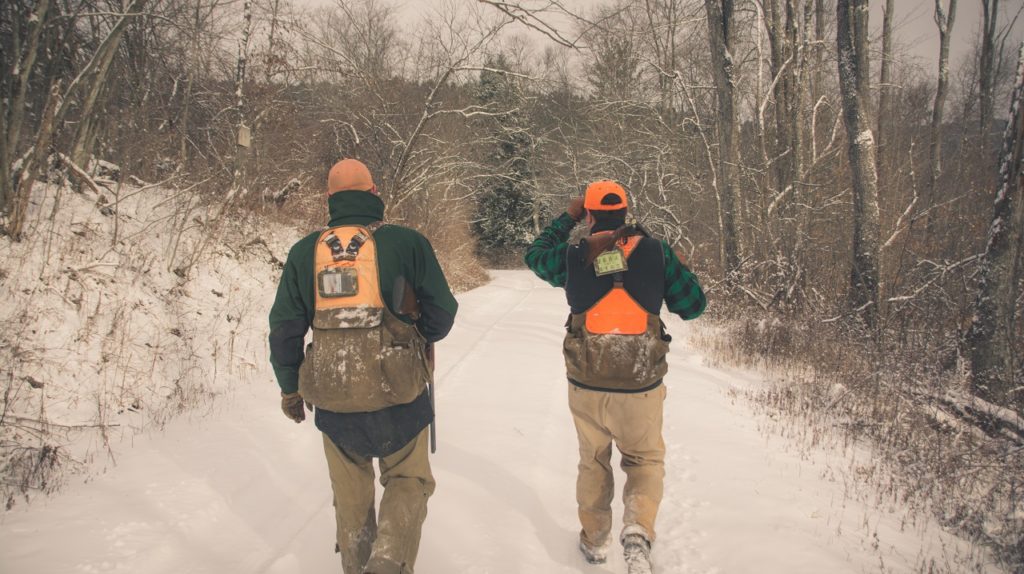
Things to consider before your next winter grouse hunt.
Here in Wisconsin, the snow is deep, and the winds are howling, and we have settled in for the winter. However, winter grouse hunting is possible and there are still areas that have not seen as much snow or cold temperatures as certain areas of the ruffed grouse range.
If I am considering going to a new area this time of year, I first do some research. Here are some of the things that I consider before heading out:
1. How much snow is on the ground?
The National Operational Hydrologic Remote Sensing Center is the place to check out for current observations for snow depth around the country. They have a very nice interactive map with which you can zoom into the area that you are interested in and check snow depth.
This is important information to consider. There’s nothing worse than taking the time to drive to an area to hunt only to find out you are in over your knees in snow and the dog can’t work the cover.
2. The next thing to consider is temperature.
I typically hunt between 10am and 3:30 pm. This allows time for the temperature to warm up and the birds will either be out feeding or having just fed. When mornings are bitter cold (below zero) I find the birds moving and feeding between 1pm and 4pm, before the temperature drops further for the night. Grouse do not move a lot in the winter months due to the fact that they carry very little fat and need to conserve what fat reserves they do have. Picking key areas to work is critical. These are typically not long hunts, 30 to 40 minutes at most. I look for specific habitat combinations.
3. Wind speed and direction.
A howling wind will drive the birds into the pines and covers that are at lower elevations, near swamps. I look for areas where the winds go over the tops of the pines instead of hitting the pines broadside.
In light winds, the birds will be out and moving, but not far from the pines. You may see them move from one clump to another. A brown bird, walking in the open on white snow, is an easy meal for a woodland predator. The shadows are a grouse’s friend.
Grouse like pines that have bows closer to the ground and are in clumps. In a dry environment, under the pines, they can blend into the shadows and escape quickly if needed.
4. Sunlight
l like to be out hunting with my setters when the sun is shining. Not only is it nice to soak in a bit of sunshine while winter grouse hunting, it just feels warmer. I imagine the same is true for the grouse. Even though they must feed, they also enjoy catching the sun rays while feeding or just sitting in a snow bowl under the pines. If possible, I try to be out during the part of the day there could be sunshine.
These are some of the weather-related things that I consider before heading out to hunt and train dogs: Where will the birds get out of the wind? Where is the sunlight? And what part of the day will produce the most ideal conditions for the birds?
5. Study habitat maps
Lastly, I sit down and study maps of habitat combinations and look for areas where habitat that grouse need in the winter come together. I look for places that make it easy for grouse to feed, loaf and escape to cover quickly. Usually, I am looking for areas where prime age aspen, older aspen, and conifers come together. If there’s a trail nearby, all the better. I also like areas where all the above come together and there is a stand of hardwoods nearby. Various hardwoods can also provide good sources of buds for the grouse to feed on. Always remember, the birds either need to walk to the food or fly to the food and they need to conserve energy so the closer the feeding cover is to the escape/roosting cover, the better.

Final Thoughts
During your late season winter winter grouse hunts, leave some birds for next year. I always keep track of how many birds I have taken from a given area knowing that the coming season’s bird population is dependent on how many birds survive the winter. The future of the local population depends on the birds we encounter on our winter grouse hunts.
So much of grouse hunting is learning as you go. You can learn something every time you flush a bird or group of birds and think about the variables that resulted in the flush. Keep at it long enough and eventually you’ll begin seeing patterns that repeat. I always think of grouse hunting like playing chess in the woods, learning to anticipate the bird’s next move. It is important to be able to read the cover, terrain changes and think about the weather and the needs of the grouse.
Success in grouse hunting does not have to be about how many birds you put in your game bag. For me, it is about putting myself and my dog in the right place at the right time to force the bird to fly up into the open. It is reading the cover and shifting myself and my dog to block and to keep the bird from escaping. Most of all, I enjoy watching my setters work the birds and put it all together before they establish point. These are the challenges that I enjoy when grouse hunting.
For more information about Scout-N-Hunt® Mobile Hunting Maps go to www.scout-n-hunt.com or www.mobilehuntingmaps.com .
Ann M Jandernoa
Northwind Enterprises, LLC info@mobilehuntingmaps.com

